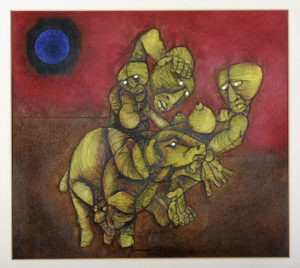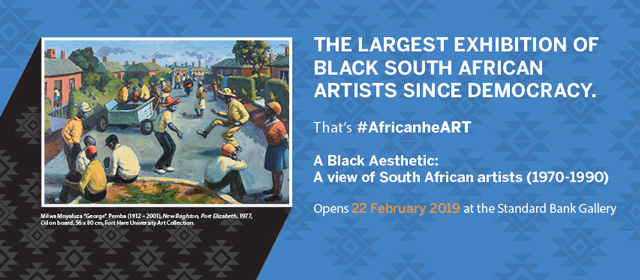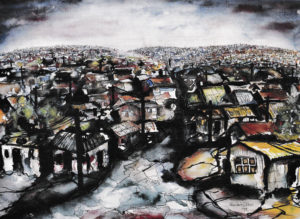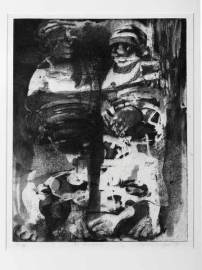
A Black Aesthetic: A View of South African Artists (1970-1990) was an exhibition in the Standard Bank Gallery in Johannesburg. The presentation was curated by Dr Same Mdluli and was praised and criticized. Mdluli deceided to react on the critique she got. For Athi Mongezeleli Joja it was necessary to respond.
Nathaniel-Nat-Ntwayakgosi Mokgosi, The Poet
Forget Criticism
A Response to Dr Same Mdluli
Dr. Same Mdluli, curator of the much talked about art exhibition at Standard Bank Gallery, entitled A Black Aesthetic: A View of South African Artists (1970-1990), has written a jolting “response” to her reviewers. Published under the title “Black Art: Its Place in the Sun” in the Mail and Guardian (M&G), although a welcomed effort, Dr. Mdluli’s response (that wasn’t quite a response) organizes itself around a set of mischievous postulations and aversions to facts. It is a considerably self-contradictory and disingenuous work of criticastering. Although she speaks of her reviewers anonymously and in plural, I will address some issues here pertaining to my own review.
In my article, published under the title A Black Aesthetic Lacks Rigour, a couple weeks before her own, I had tried to raise a few concerns. Unfortunately, my article placed emphasis on the discursive weight of the exhibition as a whole, treating it as it were an art object itself, perhaps to the detriment of the individual works of art. Nevertheless, curatorship, as an intellectual process and discipline, is and should equally be available for analysis and engagement as is the case with the artworks themselves. With that said, what struck me immediately when I saw the show was the near-complete duplication of E.J de Jager’s 1992 catalogue production of the University of Fort Hare’s art collection entitled, Images of Man: Contemporary South African Black Art and Artists. That is, in its ethnological choice of artists, in its gendered dimensions, and also in its periodization. This, in part, speaks to the historicity of racist suppositions that underwrote anthropological studies, whereby the African ceases to be a human being, but a palatable property always readily available for oculacentric dissection by the anthropologist. By isolating a passage that sketches out the motivation behind the collection’s focus on “Black artists only,” de Jager wrote that it “was a logical extension to the existing ethnological collection,” which in lieu of the growth in modern artistic practices amongst Black artists and rapid social changes, necessitated “some demarcation in the field of collection.” De Jager’s “black” exemplified by the typical specimen of the essentially African, draws from the invidious notes of colonial cataloguing of Blacks on the basis of phenotypical difference. That the collection specialized (to use his word), or prioritized, essentially black African artists, and particularly male, and yet remained totally incognizant of the self-authorized reframing of Blackness as a political category, by blacks themselves, reveals not only the recursive anthropological fetishization that underwrites the collection, but also, demonstrates the heteronomous impositions typical of colonialism’s refusal to take colonized people on their own terms.

In fact, Dr. Mdluli directly quotes the passage in her catalogue essay, and does not appear to even take pause, let alone problematize the ethnographic overtures and the presupposed anthropological essentialisations, vis-a-vis her claim that some of the featured artists “employed Black Consciousness [BC] as an intellectual means to articulate the Black condition through artistic expression.” Instead, she describes de Jager’s catalogue, in comparison to Matsemela Manaka’s Echoes of African Art (1987) and Steven Sach’s The Neglected Tradition (1988), as “the most considered of the three in terms of its interrogation of a substantive repository of the Black modern artists” [emphasis mine]. It is not clear whether Dr. Mdluli’s “idea” of blackness, and indeed her Black Aesthetics orientation, is simply an uncritical rehashing of these discursive categorical enclosures as a stance (whatever that would be) or is a case of a sheer absence of a critically discerning eye. If it is the former, we have yet to hear or read about it. But if it is the latter, something must be done. Be that as it may, the notable exclusion of so-called Coloured and Indian artists in the South African art historical oeuvre did merit a mention as something recuperative of the ethnocentric impulses that aren’t only denigratory to Black African people, but also methodologically necessary for the realization of de Jager’s essentialist and patronizing fixation with the “Township Art Movement.” We must also bare in mind that the category of township art, cements not just the ethnological fantasies at the level of the psychosomatic assumptions about the African, but it is also believed that these perceived defects are equally corroborated, exemplified, and demonstrable through their cultural accoutrements. Township art is black people and vise versa. Thus the proliferation of paintings, drawings, prints and sculptures in the show, totally excluding photography for instance, within the category of “a black aesthetics” follows that it stands as testament to Dr. Mdluli’s own form of “ethnic prancing”, as Lesego Rampolokeng might say.

Charles Nkosi, Soweto at Dawn, 1979
I also tried to show how this ethnological reproduction continues (in discontinuous tensions with BC) in her exclusion, of Black women artists from the show. Whilst bemoaning the imbalances of gender parity in the South African art world more generally, and in the Fort Hare collection specifically, Dr. Mdluli in one and the same gesture justifies why there are grounds to repeat that exclusion by deferring the inclusion of women in what seems like a latent continuity of the ethnological paradigm. This, almost as if Black women artists constitute yet another essential difference that marks them as an anomaly, within the already ethnologized “Black artists only,” and outside of it. In fact, Mdluli peddles the often repeated line that justifies Black people’s exclusion as either scarce or lacking — on Black women artists, Manaka would say on the basis of “criterion used to qualify an art object” — when she writes that the issue of Black women’s exclusion and tentative explanation of it, is “briefly discussed not because it’s a subordinate or inferior topic but because it requires elaboration on the scarceness of black women artists within a consideration of particular sociopolitical factors.” If one didn’t know better, one would assume that this line is pulled out of the pages of a 1950s anthropological booklet. In a City Press newspaper article on the controversial Black Modernism exhibition, arts writer Lwandile Fikeni quotes Dr. Mdluli’s words as follows:
“If you are going to make the claim that this exhibition should be understood as black modernisms, then you have to be conscious of what your omissions are going to imply…Not including someone like Ernest Mancoba, for example you’re in essence erasing him.”

Cyprian Mpho Shilakoe, The-Survivors, 1969.
One, therefore, can’t help wonder what became of this conviction? Here, Dr. Mdluli isn’t preoccupied with the likelihood and possibility of a prospective inclusion, but the present exclusion, as a mark of deletion. Yet, this ignoble gesture seems to reach a complication, a different register, when her own words are eviscerated by her own actions. Within the local collections alone, Dr. Mdluli could have considered the works of Bongi Dhlomo, Bonnie Ntshalintshali, Sophie Peters, Velarie Desmore, Helen Sebidi, Peter Clarke, Willie Bester, Ronald Harrison, and so on. The exhibition, as she argues, might not “follow a chronological order,” but it certainly does seem to be inflected by colonial (and sexist) justifications. These justificatory moves appear impervious of their own limitations, or worse, the fatigued tones of their insidious explanations. Raising these issues, as I mention above, came about after noticing how de Jager’s formulations repeated themselves quite obviously, not only in the curatorial unfolding of the show, but also in the truncated, thematically clustered, and generally confused conceptual and temporal logics relied upon. I mean, as I briefly suggest in my review, the trope of “the pioneer” as a singularized categorical feature — figures who open the century of Black modern art in South Africa — repeats itself, in the unproblematised fashion that temporalizes artists like Ernest Mancoba, Gerard Sekoto et al within an “age” of their own. That there’s no explanation as to why, for example, Mancoba’s paintings L’Ancetre (1971) — wrongly pictured in landscape format in the book — and even his 1990s drawings, are despite being contemporaneous with later works featured outside of the pioneers’ category, disregard the whole pontification on chronology. Equally worth mentioning, is the dubiousness in the show’s periodization (1970-1990) considering how a number of artists, or their works, precede the chosen period, not only by a considerable margin but because they were not, in the historical sense, touched by the black consciousness movement. This, of course, is not to close down the potentiality of the mobility, mutation, and correspondences within black artistic styles and work, but rather to insist on the historical accuracy and facticity, that seem to be totally ignored.

Winston Churchill Masakeng Saoli, Utwasi, 1988
2
Still, some of these arguments weren’t first expressed by my article. In fact, cultural writer Bongani Madondo had tentatively tended to them, and what makes Dr. Mdluli’s response particularly mischievous is that her “reviewers”, like tribal trinkets, are nameless. The method of namelessness, as that of misnaming, is a form of misrecognition and evisceration of “the other,” in, say, anthropological studies, which kills and buries the interlocutor under the label of anonymity, and nothingness — “a signifying property plus” as Hortense Spillers once said. Thus it was interesting to see Dr. Mdluli borrowing from this gesture in her M&G article, whilst attempting to berate the “misogynistic attitudes expressed through a trend in which certain individuals do not view and engage Black women in professional (visual art) spaces as any different to the art; that is, as objects that decorate the place” [emphasis mine]. The curator has a strange relation with onomastics, facts and details; for example that she spelled Dumile Feni’s full name (like de Jager) as Zwelidumile Geelbooi Mgxaji Mslaba (correct spelling is Mhlaba) — Geelbooi Mgxaji was Dumile’s father — is telling. The question of naming or misnaming, or sheer lack thereof, is considerably quite pervasive in art writing, and yet, this is how Dr. Mdluli deals with her reviewers: as nameless subjects categorized according to positive and negative reviewers.
Interestingly, Mdluli begins her article by citing David Koloane’s essay, Art Criticism For Whom?, which was initially a set of notes from a presentation at the International Association of Art Critics (AICA), in London, 1996. The article appears in the now seminal Art Criticism and Africa, edited by Katy Deepwell, along with the rest of the meeting’s other papers; all of which are framed around four themes, in which, by way of a question, Art Criticism for Whom? is one of them. Dr. Mdluli cites Koloane in her article as saying: “The visual arts in the South African context are often perceived as elitist and a specialist undertaking because they are associated with power and influence.” Here, Koloane highlights how racial subjugation is made visible through a sustained institutionalized racial exclusion and the attendant monopoly over means of cultural production, that make whites the only “specialists.” Art criticism, as a form of such authorizing, instantiates these exclusionary practices via unilateral and hegemonic cultural abstractions drawn out of foreign precedents, and their criterion of aesthetic judgment, are used across the board as both standard and norm. Koloane repeats this problem in some of his other writings, often returning to his remarks at AICA, in ways that, sometimes, he appears even skeptical of the very possibility of the 1990’s fictive dream of the distinctly “South African expression,” under conditions of systemic racial exclusion.
My reason for giving this background is not so much to raise objections to Koloane’s critical remarks, but to inter alia make sense of Dr. Mdluli’s haphazard applications of them. That, for example, Koloane was responding to fellow art critics, namely Joyce Ozynski and late art critic Colin Richards, is true; but what isn’t true is the reason behind them as suggested by Dr. Mdluli: that is, the claim that Richards said — which he didn’t — that “there was no art criticism in South Africa.” In fact, Richards’ remarks point specifically to “the lack of rigorous critical discourse” which apparently is “as common as a unicorn,” simply to draw our critical attention to the pervasive “hagiography, solidarity criticism — and… celebratory reflex” that not only characterizes South African art writing, but is on demand, as if it were a Public Relations duty. Funnily enough, Dr. Mdluli’s remarks that “most of the positive art reviews about the exhibition appear to have understood its intentions from the outset,” whilst “other critiques stood void of fully grasping the broader picture,” demonstrates Richards’ problem and expectation in South African art criticism. One supposes, as per her opening line, the negative reviewers, are the ones who must reckon with “simply [things that are] out of one’s depth.”
As a matter of fact, at no point does Koloane, explain “why he shouldn’t bother participating in the something that was virtually nonexistent in the broader context of the South African community” as Mdluli claims. Instead, he thinks, “[I]n view of the problems discussed, it is of utmost importance for us as compatriots in Southern Africa to consult on how we would like to see our role within our respective communities and how we can implement art criticism without excluding our communities in participation.” He subsequently goes on to suggest a number of what he considers fitting methods and solutions. Dr. Mdluli, however, doesn’t stop at just misapplying the words of David Koloane in her quest to skirt accountability for her work. She actually goes as far as to garnish her spectacular spree of distortions, bigotry and vapid elitism, with a tone of disgust when she writes, “anything can pass for art and anyone can become an artist or an art critic.” These would be, I suppose, the riffraff and members of the “brigade of pseudo-politically ambitious thinkers who lack charisma but are desperately seeking validation in the seemingly free-for-all visual art space.” Dr. Mdluli’s point is clear, the ones who lack charisma will never get validation in the exclusive reserve we call the “visual art space.” Her reprimand is unflinching. She’s totally fed up with the vagabonds who enter the world of the arts without the sophistication of some rumored scholarship. But like a rapper, Dr. Mdluli constantly promises her audience to deliver scholarship, whose actual arrival, unfortunately, drifts further away into the distance with each sentence. Here, erudition is invoked as a trope that marks her apart from the imaginary dregs of society – – not much unlike the same elitists she claims to be calling out.

Louis Khehla Maqhubela, Untitled, 1971
All of this mind you, despite the fact that hypothetically (which is to say theoretically) speaking, anything can technically become “art” and anyone can become an artist, and critic, as the knowledge boundaries of what constitutes art or criticism are constantly being reconfigured. Dr. Mdluli’s tone isn’t to affirm the potentiality thereof though, but rather it seems hellbent on denying this possibility. The thingliness of anything and the abstract “one,” not too many years ago were untravelling descriptive markers of the racist lingua-franca used to define African art and African people. Thus Dr. Mdluli’s project here vacillates between condemning the art world’s historical elitism, whilst simultaneously deliberately relying on it. As depressing as this is, Koloane’s writing is dragged kicking and screaming to give Dr. Mdluli’s pontification gravitas. Her glaring distortions are quite astonishing, despite her fetishitic — *coughes* elitist — claims to scholarship. They are belittling in their posture. Her position that black women are denigrated by these unnamed and unnamable doyens of patriarchy, when her own show palpably excludes black women artists is a puzzling one. It makes a mockery of the culture of calling-out misogyny, by abstracting and weaponizing its rhetorical content for her expedient and self-interested gains. Patriarchy becomes her imaginary object of rebuke – – not because it doesn’t necessarily exist nor that most of us aren’t culpable and/or guilty of it (because it most certainly does and we most certainly are) – – to hide her proactive recapacitation of it and functionality within the narratological schemas of her recent writings and curatorial work. Dr. Mdluli uses gender only when it suits her personal interests, and seems to never think twice about even jettisoning the term when she doesn’t need it. Consider this line from her catalogue essay, when she writes apropos how black modern art affects black aesthetics:
“it affirms this [Black Aesthetic] by suggesting that there’s a way of looking at and seeing art produced by certain artists informed by specific factors, whether these are social, political or economic. Such factors also tend to affect the way the viewer and the subject engage, and in this case, race and class become critical features of how artists of a particular era are defined and situated within a broader art narrative” [emphasis mine].
But now consider her view in the M&G piece, when she scolds misogyny, “[A]t the centre of this institutional power — as many areas of research and study have revealed, including in the visual art discourse — is how patriarchy in particular has played a role in shaping race, class and gender relations in every facet of society” [emphasis mine].
I draw your attention to this disparity to locate the ways in which patriarchy is discursively, on one side, a non-issue, in how the intersubjective relations are formed, whilst on the other, the generality of patriarchy — in its supposed essential and departicularised sense — operates as a pervasive disease that shapes race, class and gender. But again, that patriarchy shapes race, class and gender is presented neither as a clear enough point nor something that is clarified in the piece. What is clear though, is that gender is a contingently mobilized category, used as a scarecrow to scare off criticism.The kind of mudslinging and ad hominem caricature of her supposed negative reviewers, borders on a very cultish expectation akin to the current political moment, where criticism is only a right in so far as you abrogate its use. As thinkers like James Elkins and Jolanta Nowak, might argue that the abrogation of the critic’s right to criticize speaks to the reluctance towards judgment. Essentially, the ironic judgement is that criticism means one can do anything except what is central to critique, that is to pass a judgmental remark. This has deep ramifications for art criticism as it does for possibilities of changing the institutional cultures of exclusion. This, of course, isn’t to say that Dr. Mdluli has the innate capacity to systemically defang institutionalized racism, gender, patriarchy etc. within Standard Bank Gallery, however, her complicity, which though intellectual, does have material ramifications. Dr. Same Mdluli’s writings and curatorial work in the realization of A Black Aesthetic, exemplify a pervasive and common feature of not only our cultural field but also, sadly, of the state of our country. A resident problem of anti-intellectual intellectual posturing.
In the main, her project seems to only insist that we forget art criticism as form of critical participation in the visual arts. Art criticality, it seems, is only possible if it does not step on toes or explain, in a critical fashion, the misadventures of our deeply problematic cultural field. If that is the case, we are clearly not mitigating the mediocrity parading around with celebrated virility, we are abetting it.
